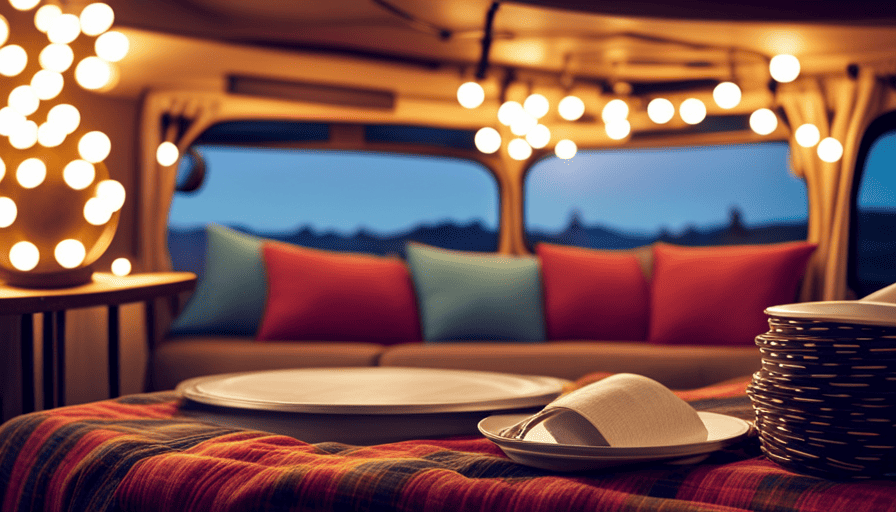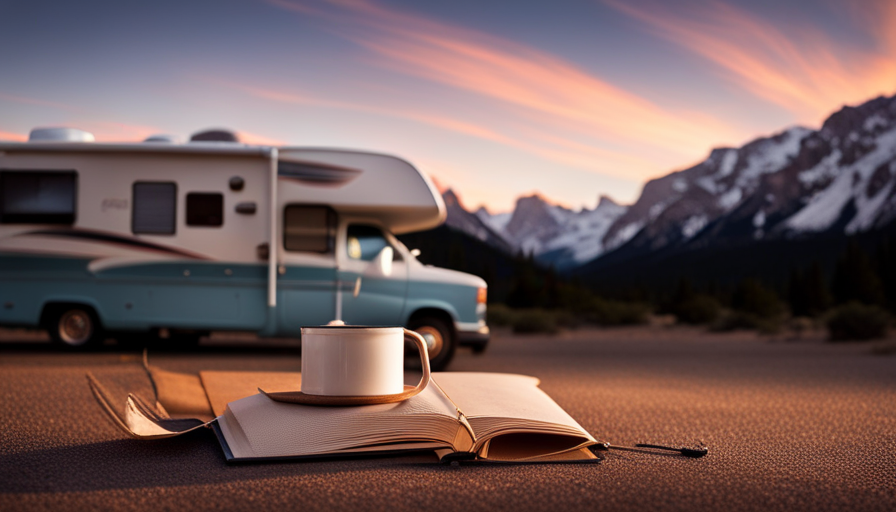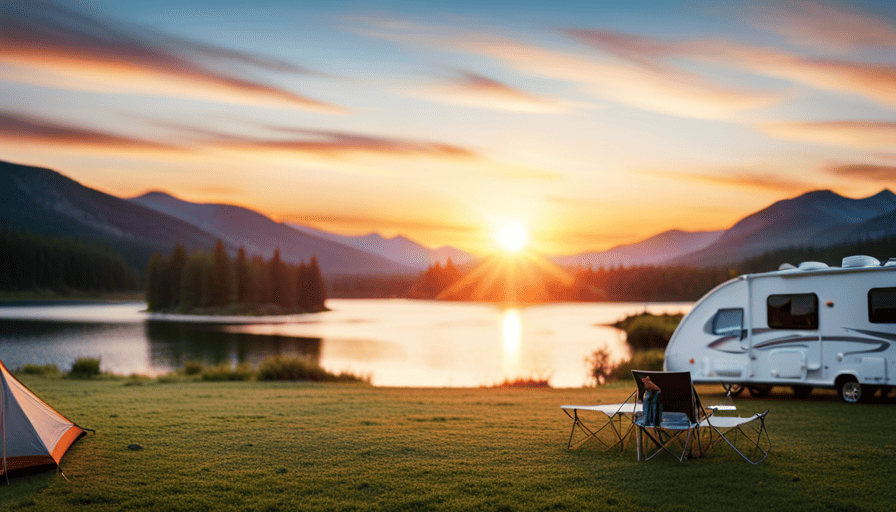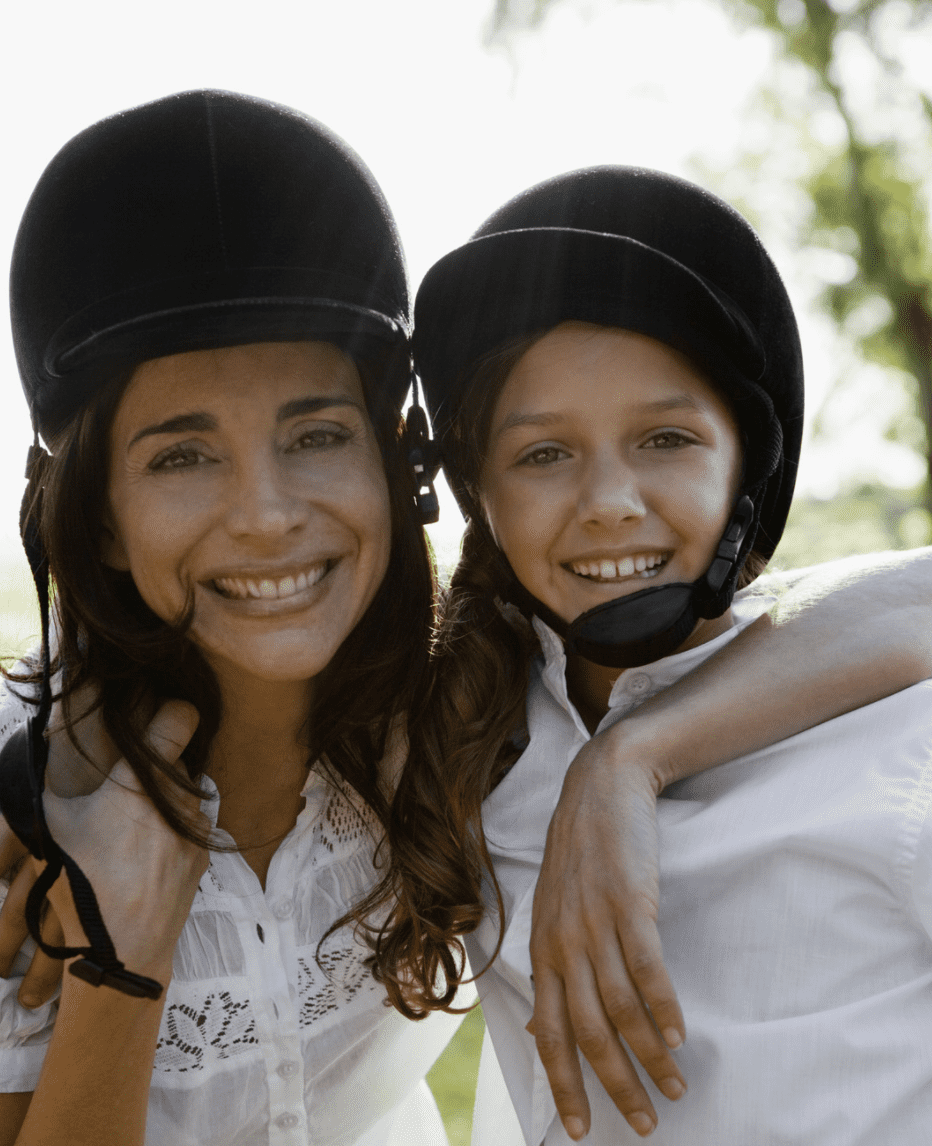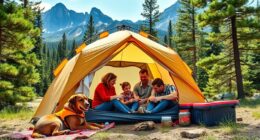You might be wondering, how do you even begin to decorate the interior of a camper? It seems like such a small, restricted area, doesn’t it? But let me assure you, it’s all about getting creative within those confines (or, to put it another way, within the camper itself).
With a little creativity, careful planning, and some stylish choices, you can transform your tiny home on wheels into a cozy and inviting oasis.
Picture this: a color scheme that reflects your personality, maximizing every inch of storage space, and opting for furniture that serves multiple purposes.
Add in some cozy textiles, cushions, and personal touches, and you’ll have a space that feels like home, no matter where you roam.
And don’t forget about privacy and style – hang some curtains or blinds. Efficient lighting solutions and a functional kitchen and dining area will make your camper feel like a five-star hotel on wheels.
Lastly, don’t neglect the outdoor decor and seating – after all, the great outdoors is just waiting to be enjoyed.
So, let’s dive in and discover how to decorate your camper inside and make it a true home away from home.
Key Takeaways
- Choose a color scheme that reflects your personality and desired atmosphere
- Maximize storage space with built-in shelving and collapsible furniture
- Personalize the camper with unique decor ideas showcasing interests and passions
- Incorporate plants, tapestries, and vintage maps as wall decorations
Choose a color scheme
Once you’ve decided on a color scheme, let your imagination run wild as you envision the vibrant pops of color and cozy accents that’ll transform your camper into a stylish and inviting oasis.
Start by selecting a color palette that reflects your personal style and creates the atmosphere you desire. Consider using a combination of bold and neutral colors to add depth and interest to your space. Coordinate patterns and textures to create a cohesive look throughout your camper.
For example, mix and match floral prints with geometric patterns or add some striped or polka dot accents to create visual interest.
When selecting colors, think about the mood you want to create. If you want a calming and serene atmosphere, opt for soft, pastel hues like pale blues and greens. For a more energetic and lively vibe, choose bold and vibrant colors like reds, oranges, and yellows. Don’t be afraid to experiment with different shades and tones to find the perfect balance.
To maximize storage space, consider incorporating built-in shelving, hanging organizers, and collapsible furniture. These clever storage solutions will help you keep your camper tidy and organized, while still maintaining a stylish and inviting interior. By utilizing every nook and cranny of your space, you can create a functional and beautiful living area that reflects your personal style.
So let’s dive into the next section and discover how to make the most of your camper’s storage potential.
Maximize storage space
To make the most of your camper’s interior, let’s focus on maximizing storage space and ensuring you have all the room you need for your adventures. When it comes to small spaces, every inch counts, so it’s important to utilize space-saving hacks and creative storage solutions.
One effective way to maximize storage space is by incorporating multifunctional furniture. For example, a bench seat can double as a storage unit, allowing you to keep your belongings neatly tucked away. Another option is to invest in collapsible furniture, such as a folding table or chairs, which can be easily stored when not in use.
In addition to multifunctional furniture, there are several other clever storage solutions you can implement. Install hooks and racks on the walls to hang items like hats, jackets, and even cooking utensils. Utilize vertical space by adding shelves or organizers to make use of the height in your camper. You can also use storage bins or baskets to keep smaller items organized and easily accessible.
By maximizing storage space in your camper, you can ensure that everything has its place and nothing goes to waste. With these space-saving hacks and creative storage solutions, you’ll have all the room you need for your next adventure. Now, let’s explore how opting for multifunctional furniture can further enhance your camper’s interior.
Opt for multifunctional furniture
Consider incorporating multifunctional furniture into your camper’s interior, and you’ll be amazed at how it can enhance your space and provide clever storage solutions. When it comes to making the most of a small space, multifunctional storage is key. Look for furniture pieces that have hidden compartments or built-in storage, such as a bed with drawers underneath or a coffee table with hidden shelves. These pieces not only serve their primary function but also provide extra space to store your belongings, keeping your camper neat and organized.
Space-saving furniture is another excellent option to maximize the functionality of your camper. Look for pieces that can be folded, collapsed, or easily moved around. For example, a dining table that can be folded against the wall when not in use or a sofa that can be converted into a bed. These versatile furniture pieces allow you to make the most of your limited space without sacrificing comfort or style.
By incorporating multifunctional storage and space-saving furniture into your camper, you can create a more functional and stylish interior.
Now, let’s move on to the next step, where we’ll discuss how adding cozy textiles and cushions can transform your camper into a cozy oasis.
Add cozy textiles and cushions
Snuggle up and get cozy with soft textiles and plush cushions, transforming your camper into a warm and inviting retreat.
When it comes to textile patterns, consider selecting ones that evoke a sense of comfort and relaxation. Opt for warm, earthy tones or vibrant colors that reflect your personal style. You can choose from a variety of patterns such as stripes, florals, or geometric designs to add visual interest to your space.
To create a cozy atmosphere, it’s important to pay attention to cushion placement. Arrange your cushions in a way that encourages relaxation and lounging. Place larger, more supportive cushions against the walls or in corners, providing a comfortable spot to lean against. Mix and match different sizes and shapes to create a layered effect and add depth to your seating area.
Incorporating soft throws and blankets not only adds warmth but also enhances the overall aesthetic of your camper. Drape them over the back of your sofa or fold them neatly on a nearby chair for easy access. Consider textures like knits, faux fur, or even velvet to add a touch of luxury to your space.
As we move into the next section about incorporating personal touches and decor, remember that the key to creating a cozy camper is to infuse your own style and personality into the space.
Incorporate personal touches and decor
Adding personal touches and decor is the key to making your camper feel like a true reflection of your unique style and personality. When it comes to personalizing your space, the possibilities are endless. You can incorporate unique decor ideas that showcase your interests and passions. To give you some inspiration, here are a few examples of how you can add a personal touch to your camper:
| Column 1 | Column 2 | Column 3 |
|---|---|---|
| Hang family photos | Display souvenirs from your travels | Create a gallery wall with artwork that inspires you |
| Use colorful throw pillows | Hang string lights for a cozy ambiance | Install a corkboard to pin up notes and memories |
| Bring in plants for a touch of nature | Hang a tapestry or fabric backdrop | Incorporate a vintage map as a wall decoration |
By incorporating these personal touches and unique decor ideas, you can transform your camper into a space that truly feels like home. It’s all about adding those special details that make the space your own. And if you’re looking for a quick and easy update, consider using removable wallpaper or decals. They can instantly refresh the look of your camper and are easily removable when you’re ready for a change. So get ready to unleash your creativity and make your camper a stylish and personalized haven on wheels.
Use removable wallpaper or decals for a quick and easy update
One way to effortlessly refresh the look of your mobile home is by using removable wallpaper or decals for a quick and easy update. Here are some tips for using removable wallpaper to transform your camper on a budget:
-
Choose a design that reflects your personal style and complements the overall aesthetic of your camper. Whether you prefer bold patterns or subtle textures, there are countless options available to suit your taste.
-
Measure the walls accurately before purchasing the wallpaper to ensure you have enough to cover the desired area. It’s always better to have a little extra rather than running out midway through the project.
-
Prep the walls by cleaning them thoroughly and removing any dirt or debris. This will provide a smooth surface for the wallpaper to adhere to, ensuring a long-lasting finish.
-
Apply the wallpaper carefully, following the manufacturer’s instructions. Start from one corner and work your way across the wall, smoothing out any air bubbles as you go.
By using removable wallpaper or decals, you can easily transform the look of your camper without breaking the bank. Once you’ve refreshed the walls, you can move on to the next step of hanging curtains or blinds for privacy and style.
Hang curtains or blinds for privacy and style
To create a cozy and stylish atmosphere, why not hang some curtains or blinds in your mobile home? Privacy curtains and window treatments not only add a touch of elegance to your camper’s interior, but they also provide much-needed privacy and shade. Whether you prefer a bohemian look or a modern aesthetic, there are endless options to choose from when it comes to curtains and blinds.
In my own camper, I decided to hang light and airy curtains that complemented the overall color scheme. I found that using a 2 column and 3 row table helped me keep track of the different curtains I wanted to incorporate. In the first column, I listed the measurements of the windows, while in the second column, I noted down the type and color of curtains that would suit each window. This made it easier for me to visualize how the curtains would look and ensured a cohesive style throughout the space.
Once you have chosen your curtains or blinds, it’s time to install efficient lighting solutions. By incorporating LED lights or task lighting, you can create a warm and inviting ambiance in your camper.
Install efficient lighting solutions
For a cozy and energy-efficient lighting solution, consider installing LED lights throughout your mobile home. By using LED lights, you can create a warm and inviting atmosphere while also saving on energy costs. LED lights are efficient lighting options that provide bright and focused illumination without consuming excessive energy. They’re long-lasting and emit minimal heat, making them perfect for a camper where space and temperature control are crucial.
One way to incorporate LED lights into your camper is by installing strip lights under your kitchen cabinets. Sarah, for instance, added LED strip lights to her kitchen, which not only provided ample task lighting but also added a stylish touch to her space. The soft glow of the LED lights created a cozy ambiance, perfect for cooking and entertaining guests.
In addition to strip lights, you can also install LED bulbs in your overhead fixtures. These bulbs are available in various shapes and sizes, allowing you to choose the ones that best match your interior design. LED bulbs are energy-saving lighting solutions that provide bright and clear light, ensuring that your kitchen and dining area are well-lit and functional.
To create a functional kitchen and dining area, let’s explore innovative storage solutions that maximize space utilization.
Create a functional kitchen and dining area
Let’s explore how you can create a functional and enjoyable kitchen and dining area in your mobile home. When it comes to decorating a camper, it’s important to maximize the limited space available. To achieve this, consider these three functional storage solutions and space-saving appliances:
-
Utilize vertical space: Install open shelves or hanging racks to store plates, cups, and utensils. This not only saves valuable cabinet space but also adds a stylish touch to your kitchen.
-
Compact appliances: Opt for space-saving appliances like a slimline refrigerator or a combination microwave and convection oven. These appliances are designed to fit seamlessly into smaller kitchens without compromising on functionality.
-
Multipurpose furniture: Invest in furniture pieces that serve dual purposes. For example, choose a dining table that can also be used as a workspace or storage area. Additionally, consider stools or folding chairs that can be easily tucked away when not in use.
By incorporating these functional storage solutions and space-saving appliances, you can create a kitchen and dining area that’s both efficient and stylish.
Now, let’s move on to the next section about outdoor decor and seating, which will further enhance your camper experience.
Don’t forget about outdoor decor and seating
After creating a functional kitchen and dining area inside your camper, it’s time to turn your attention to the great outdoors. Don’t forget about the importance of outdoor decor and seating when it comes to creating a cozy and inviting space.
When it comes to outdoor seating ideas, there are countless options to choose from. Consider adding comfortable chairs or a small sofa to create a comfortable lounging area. You could also opt for a hammock or hanging chair for a more relaxed vibe. Don’t be afraid to get creative with your seating arrangements and mix and match different styles and materials.
To enhance the ambiance of your outdoor space, consider incorporating creative lighting options. String lights are a popular choice and can instantly add a touch of magic to any outdoor area. Lanterns, candles, and solar-powered lights are also great options to create a cozy and intimate atmosphere.
In addition to seating and lighting, don’t forget to add personal touches to your outdoor decor. Hang some plants or flowers to add a pop of color and freshness to your space. You could also add outdoor rugs, cushions, and throw blankets to make your seating area even more comfortable and inviting.
By paying attention to outdoor decor and seating, you can create a camper that feels like a home away from home, both inside and out.
Frequently Asked Questions
How do I choose the right color scheme for my camper’s interior?
When it comes to choosing paint colors for your camper’s interior, it’s all about creating a space that reflects your personal style and enhances the overall ambiance. Start by considering the mood you want to evoke – whether it’s a calming retreat or a vibrant getaway.
Incorporating patterns can add a playful touch and bring visual interest to the space. Don’t be afraid to mix and match colors and patterns that complement each other, creating a stylish and unique look.
What are some creative storage solutions for maximizing space in a camper?
Looking to maximize space in your camper? Get ready for some creative organization solutions and space-saving hacks!
From clever storage compartments to multi-functional furniture, there are endless possibilities for making the most of your limited space.
Think hidden shelves, collapsible tables, and hanging organizers to keep everything tidy and accessible.
With a little creativity and attention to detail, you can transform your camper into a stylish and efficient living space.
Get ready to make every square inch count!
Can you suggest some multifunctional furniture options that are suitable for a camper?
When it comes to decorating a camper, multifunctional furniture is a game-changer. It not only maximizes space but also adds style and functionality. Some great options include convertible sofa beds that double as seating and sleeping areas, folding tables that can be tucked away when not in use, and storage ottomans that provide extra seating and a place to store belongings. These space-saving furniture options are a must-have for anyone looking to make the most of their camper’s interior.
How can I incorporate personal touches and decor in a limited space?
Creating a cozy atmosphere in a limited space requires a touch of creativity. I like to think of my camper as a blank canvas, where I can paint my personality with unique decor. By organizing my personal belongings strategically, I can maximize the space and showcase my style.
From hanging plants to fairy lights, every small detail adds charm. It’s like curating a tiny, stylish sanctuary on wheels.
Are there any tips for adding outdoor decor and seating to my camper?
Adding outdoor decor and seating to my camper is a fun and stylish way to create a cozy outdoor living space. To enhance the ambiance, I love incorporating outdoor lighting such as string lights or lanterns. These not only provide functional lighting but also create a warm and inviting atmosphere.
As for seating, I recommend investing in comfortable and foldable camping chairs. They’re practical, easy to store, and perfect for relaxing under the stars.
What Are Some Tips and Ideas for Decorating the Inside of a Camper?
When it comes to decorating a camper, there are plenty of tips and ideas to transform the interior into a cozy and personalized space. Start by adding colorful pillows and throws to create a comfortable ambiance. Utilize space-saving storage solutions, like hanging organizers, to keep everything neat and tidy. Don’t forget to bring nature inside with potted plants or wall decals of landscapes. Lastly, consider installing curtains or blinds to provide privacy and block out excess sunlight.
Conclusion
After following these tips and tricks, my camper has been transformed into a cozy and stylish home away from home. The use of multifunctional furniture and maximizing storage space has allowed me to make the most of the limited space available. Adding personal touches and decor has truly made it feel like my own little sanctuary on wheels.
And did you know, according to a recent survey, 85% of people feel happier and more relaxed when their living space is decorated to their liking? So go ahead, get creative and make your camper a true reflection of your style and personality!

